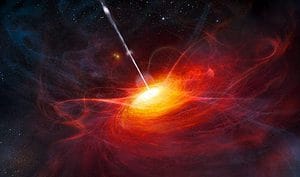
Quasars are some of the brightest objects in the Universe. Their formed after black holes devour captured material, like gas dust and stars that come too close, and release bright light that can be seen across the universe. Most of the popular astronomy today is orientated towards the particularly extremely bright quasars; those formed in a singular event consisting of the merger of a black holes with other galaxies that drive huge streams of gas and dust into their centers.
A new NASA survey however has found that more often than not, there are fainter quasars that thrive in normal-looking spiral galaxies, making the bulk of the Universe’s quasar population. A census of 30 quasar host galaxies was conducted by Hubble and Spitzer. Of these, 26 of the host galaxies show no particular sign of a cosmic collision with neighbors, an event usually signaled by distorted shapes. Of the rest, only one galaxy in the sample shows evidence of an interaction with another galaxy.
“The brilliant quasars born of galaxy mergers get all the attention because they are so bright and their host galaxies are so messed up,” Yale University astronomer Kevin Schawinski said in a statement. “But the typical bread-and-butter quasars are actually where most of the black-hole growth is happening. They are the norm, and they don’t need the drama of a collision to shine.”

The quasars were observed in infrared light, which can pierce through the dust that often shrouds galaxies in optical light. They’re estimated to have existed roughly 8 billion to 12 billion years ago, a time when black hole growth was at a peak.
Black holes are slow eaters, not excited gobblers. No word on table manners, though
What makes this discovery really important is the fact that it now offers substantial proof, backing the claim that the growth of most massive black holes in the early universe was fueled by small, long-term events rather than dramatic short-term major mergers. What does it take to make a quasar, though? According to the NASA researchers, typically a black hole doesn’t need too much gas to unleash a quasar.
“There’s more than enough gas within a few light-years from the center of our Milky Way to turn it into a quasar,” Schawinski explained. “It just doesn’t happen. But it could happen if one of those small clouds of gas ran into the black hole. Random motions and stirrings inside the galaxy would channel gas into the black hole. Ten billion years ago, those random motions were more common and there was more gas to go around. Small galaxies also were more abundant and were swallowed up by larger galaxies.”
Not very much is known about quasar, particularly because they’re so difficult to observe and study. This might change once with the launch of the James Webb Telescope, a massive, cutting-edge space telescope designed to orbit 1 million miles from Earth, where it would observe the mid-infrared portion of the electromagnetic spectrum.
To get to the heart of what kinds of events are powering the quasars in these galaxies, we need the Webb telescope. Hubble and Spitzer have been the trailblazers for finding them.”
Findings were published in the journal Monthly Notices of the Royal Astronomical Society.
via space.com






